Analysis of Atman, Samsara, and Karma in Hindu Philosophy & Religion
VerifiedAdded on 2023/06/04
|5
|995
|345
Essay
AI Summary
This essay explores the interconnected concepts of Atman (soul), Samsara (cycle of birth, death, and rebirth), and Karma (action and consequence) within the framework of Hindu philosophy, particularly in relation to the Bhagavad Gita. Karma dictates the experiences within Samsara, influencing the purification and journey of the Atman. The essay highlights that Karma emphasizes the cause-effect relationship of actions, maintaining Dharma, while Samsara represents the cycle influenced by Karma. The ultimate goal is Moksha, liberation from Samsara, achieved through understanding and purifying the Atman, with meditation playing a crucial role in realizing the spiritual existence beyond the physical body. The document is available on Desklib, a platform offering a range of study tools for students.
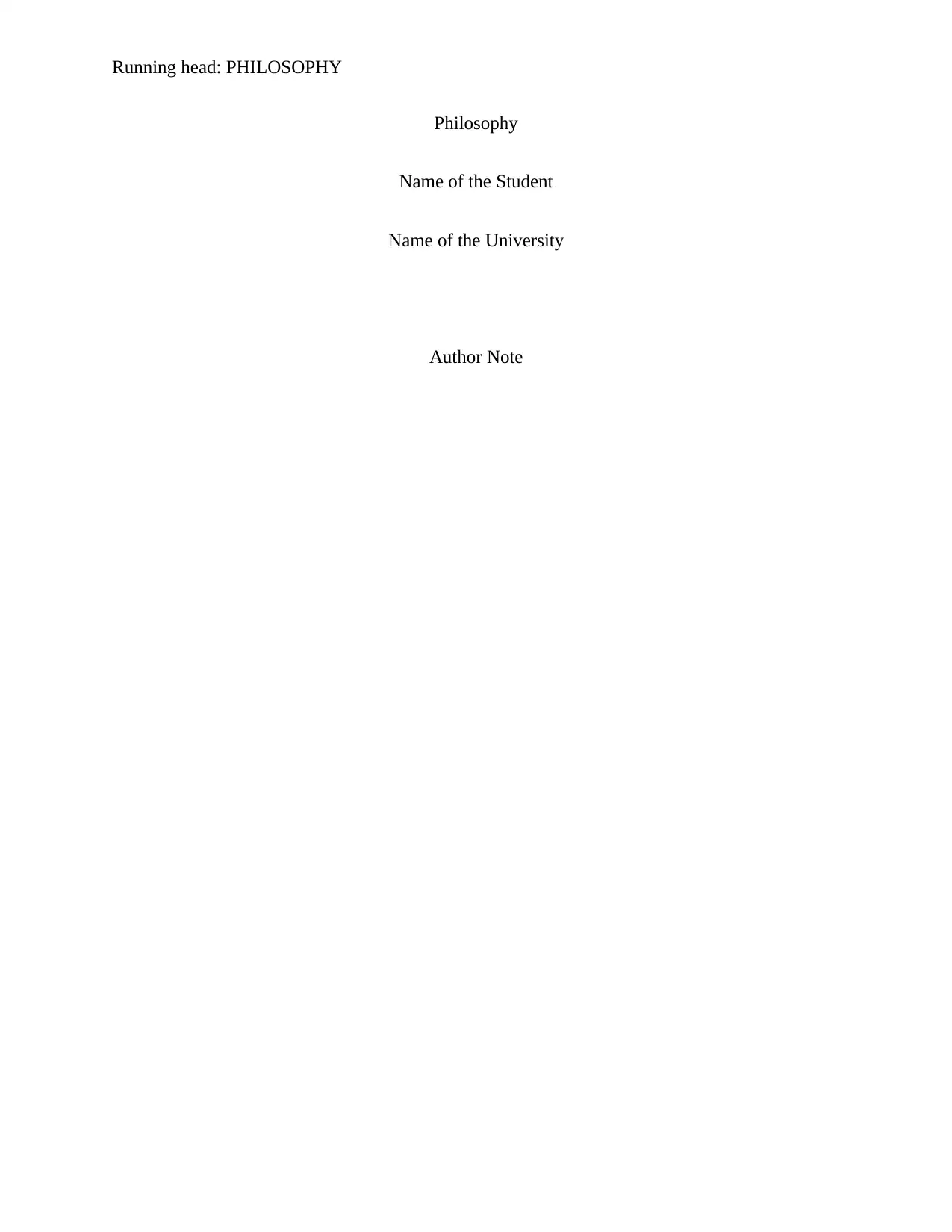
Running head: PHILOSOPHY
Philosophy
Name of the Student
Name of the University
Author Note
Philosophy
Name of the Student
Name of the University
Author Note
Paraphrase This Document
Need a fresh take? Get an instant paraphrase of this document with our AI Paraphraser
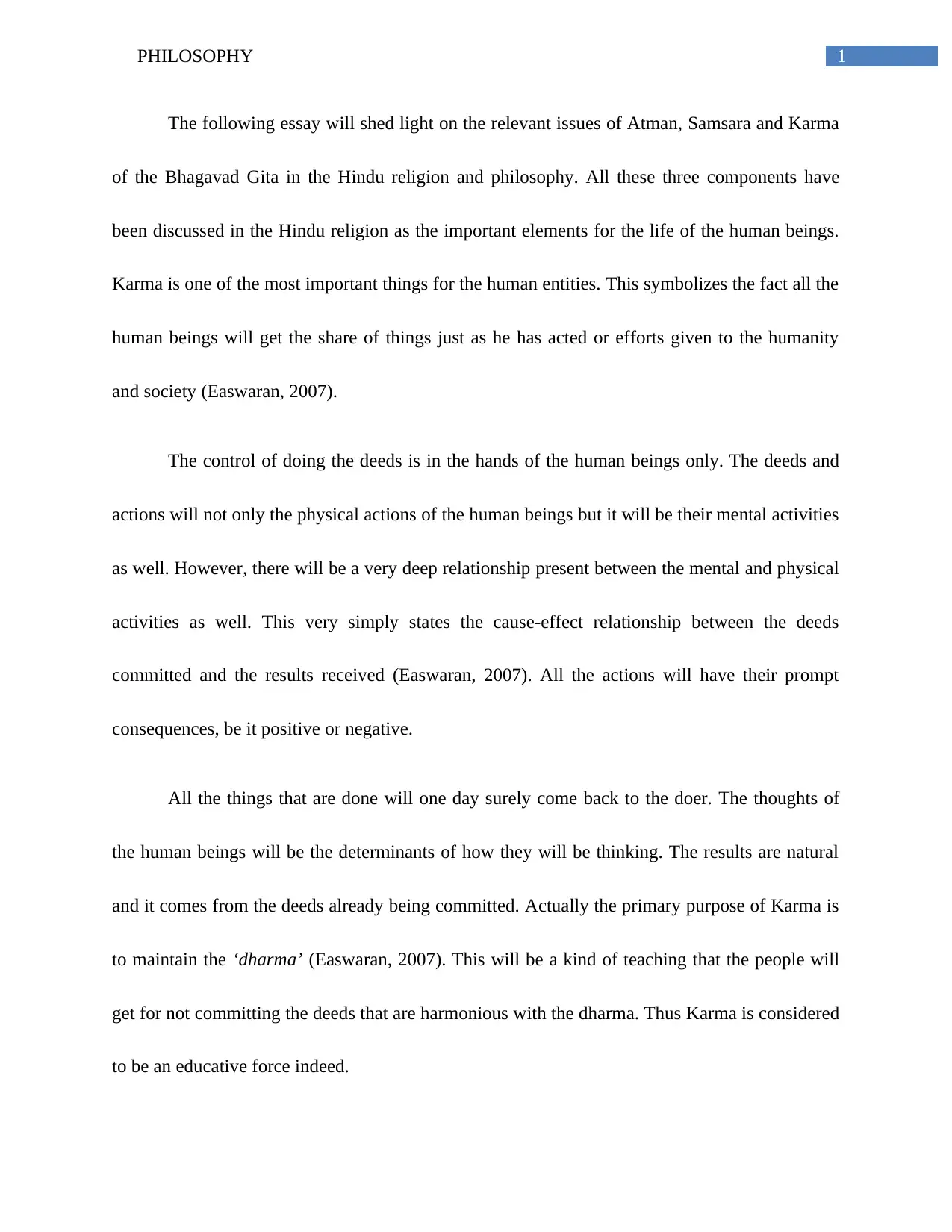
1PHILOSOPHY
The following essay will shed light on the relevant issues of Atman, Samsara and Karma
of the Bhagavad Gita in the Hindu religion and philosophy. All these three components have
been discussed in the Hindu religion as the important elements for the life of the human beings.
Karma is one of the most important things for the human entities. This symbolizes the fact all the
human beings will get the share of things just as he has acted or efforts given to the humanity
and society (Easwaran, 2007).
The control of doing the deeds is in the hands of the human beings only. The deeds and
actions will not only the physical actions of the human beings but it will be their mental activities
as well. However, there will be a very deep relationship present between the mental and physical
activities as well. This very simply states the cause-effect relationship between the deeds
committed and the results received (Easwaran, 2007). All the actions will have their prompt
consequences, be it positive or negative.
All the things that are done will one day surely come back to the doer. The thoughts of
the human beings will be the determinants of how they will be thinking. The results are natural
and it comes from the deeds already being committed. Actually the primary purpose of Karma is
to maintain the ‘dharma’ (Easwaran, 2007). This will be a kind of teaching that the people will
get for not committing the deeds that are harmonious with the dharma. Thus Karma is considered
to be an educative force indeed.
The following essay will shed light on the relevant issues of Atman, Samsara and Karma
of the Bhagavad Gita in the Hindu religion and philosophy. All these three components have
been discussed in the Hindu religion as the important elements for the life of the human beings.
Karma is one of the most important things for the human entities. This symbolizes the fact all the
human beings will get the share of things just as he has acted or efforts given to the humanity
and society (Easwaran, 2007).
The control of doing the deeds is in the hands of the human beings only. The deeds and
actions will not only the physical actions of the human beings but it will be their mental activities
as well. However, there will be a very deep relationship present between the mental and physical
activities as well. This very simply states the cause-effect relationship between the deeds
committed and the results received (Easwaran, 2007). All the actions will have their prompt
consequences, be it positive or negative.
All the things that are done will one day surely come back to the doer. The thoughts of
the human beings will be the determinants of how they will be thinking. The results are natural
and it comes from the deeds already being committed. Actually the primary purpose of Karma is
to maintain the ‘dharma’ (Easwaran, 2007). This will be a kind of teaching that the people will
get for not committing the deeds that are harmonious with the dharma. Thus Karma is considered
to be an educative force indeed.
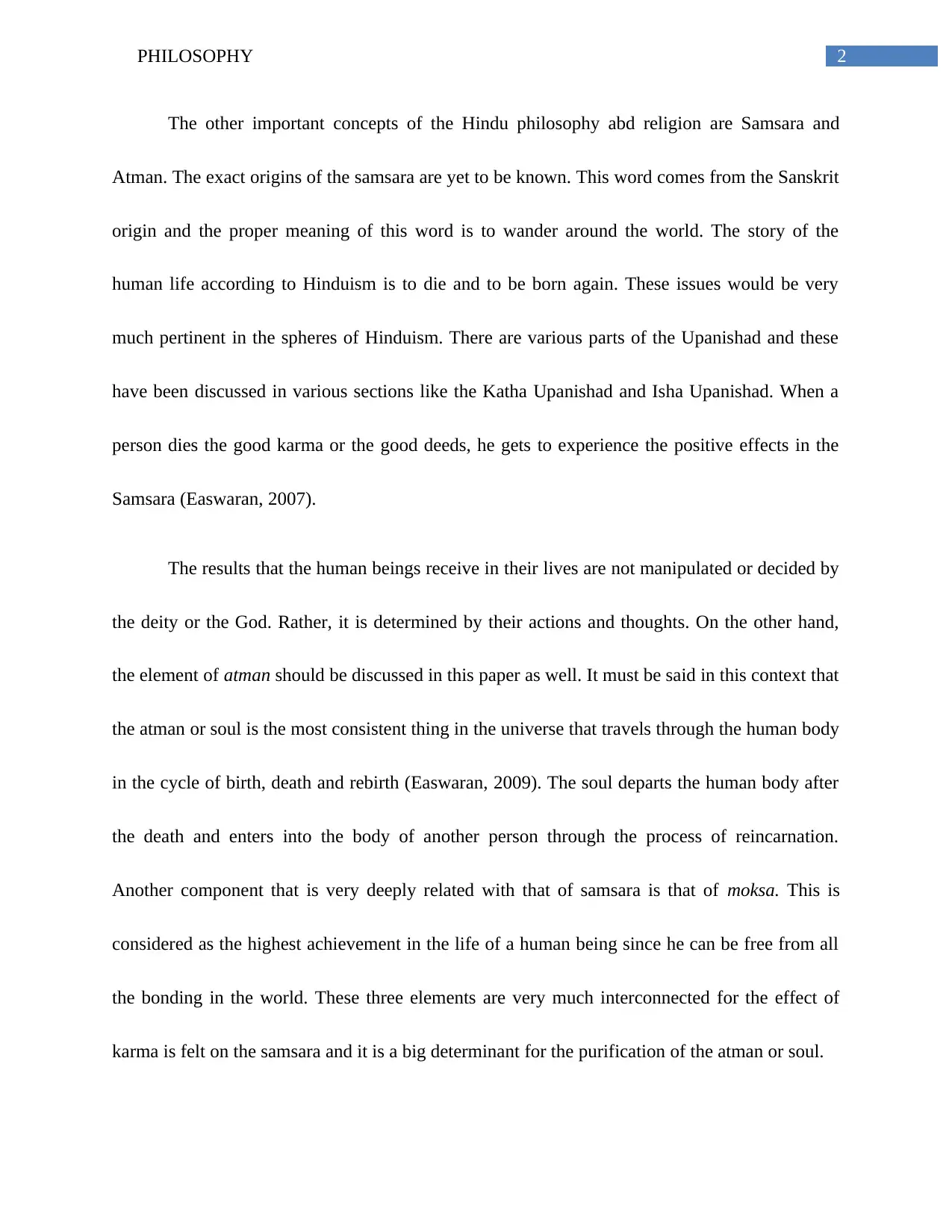
2PHILOSOPHY
The other important concepts of the Hindu philosophy abd religion are Samsara and
Atman. The exact origins of the samsara are yet to be known. This word comes from the Sanskrit
origin and the proper meaning of this word is to wander around the world. The story of the
human life according to Hinduism is to die and to be born again. These issues would be very
much pertinent in the spheres of Hinduism. There are various parts of the Upanishad and these
have been discussed in various sections like the Katha Upanishad and Isha Upanishad. When a
person dies the good karma or the good deeds, he gets to experience the positive effects in the
Samsara (Easwaran, 2007).
The results that the human beings receive in their lives are not manipulated or decided by
the deity or the God. Rather, it is determined by their actions and thoughts. On the other hand,
the element of atman should be discussed in this paper as well. It must be said in this context that
the atman or soul is the most consistent thing in the universe that travels through the human body
in the cycle of birth, death and rebirth (Easwaran, 2009). The soul departs the human body after
the death and enters into the body of another person through the process of reincarnation.
Another component that is very deeply related with that of samsara is that of moksa. This is
considered as the highest achievement in the life of a human being since he can be free from all
the bonding in the world. These three elements are very much interconnected for the effect of
karma is felt on the samsara and it is a big determinant for the purification of the atman or soul.
The other important concepts of the Hindu philosophy abd religion are Samsara and
Atman. The exact origins of the samsara are yet to be known. This word comes from the Sanskrit
origin and the proper meaning of this word is to wander around the world. The story of the
human life according to Hinduism is to die and to be born again. These issues would be very
much pertinent in the spheres of Hinduism. There are various parts of the Upanishad and these
have been discussed in various sections like the Katha Upanishad and Isha Upanishad. When a
person dies the good karma or the good deeds, he gets to experience the positive effects in the
Samsara (Easwaran, 2007).
The results that the human beings receive in their lives are not manipulated or decided by
the deity or the God. Rather, it is determined by their actions and thoughts. On the other hand,
the element of atman should be discussed in this paper as well. It must be said in this context that
the atman or soul is the most consistent thing in the universe that travels through the human body
in the cycle of birth, death and rebirth (Easwaran, 2009). The soul departs the human body after
the death and enters into the body of another person through the process of reincarnation.
Another component that is very deeply related with that of samsara is that of moksa. This is
considered as the highest achievement in the life of a human being since he can be free from all
the bonding in the world. These three elements are very much interconnected for the effect of
karma is felt on the samsara and it is a big determinant for the purification of the atman or soul.
⊘ This is a preview!⊘
Do you want full access?
Subscribe today to unlock all pages.

Trusted by 1+ million students worldwide
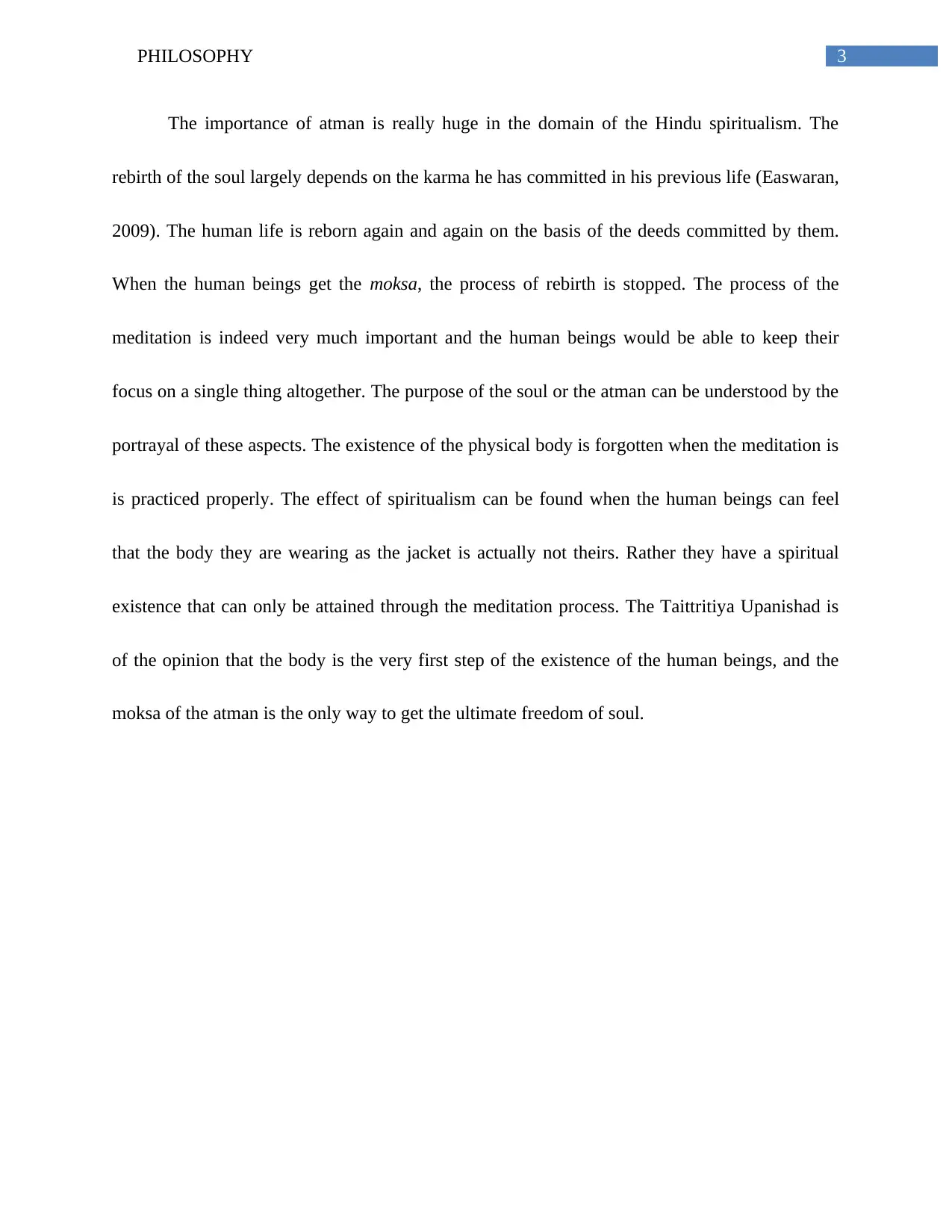
3PHILOSOPHY
The importance of atman is really huge in the domain of the Hindu spiritualism. The
rebirth of the soul largely depends on the karma he has committed in his previous life (Easwaran,
2009). The human life is reborn again and again on the basis of the deeds committed by them.
When the human beings get the moksa, the process of rebirth is stopped. The process of the
meditation is indeed very much important and the human beings would be able to keep their
focus on a single thing altogether. The purpose of the soul or the atman can be understood by the
portrayal of these aspects. The existence of the physical body is forgotten when the meditation is
is practiced properly. The effect of spiritualism can be found when the human beings can feel
that the body they are wearing as the jacket is actually not theirs. Rather they have a spiritual
existence that can only be attained through the meditation process. The Taittritiya Upanishad is
of the opinion that the body is the very first step of the existence of the human beings, and the
moksa of the atman is the only way to get the ultimate freedom of soul.
The importance of atman is really huge in the domain of the Hindu spiritualism. The
rebirth of the soul largely depends on the karma he has committed in his previous life (Easwaran,
2009). The human life is reborn again and again on the basis of the deeds committed by them.
When the human beings get the moksa, the process of rebirth is stopped. The process of the
meditation is indeed very much important and the human beings would be able to keep their
focus on a single thing altogether. The purpose of the soul or the atman can be understood by the
portrayal of these aspects. The existence of the physical body is forgotten when the meditation is
is practiced properly. The effect of spiritualism can be found when the human beings can feel
that the body they are wearing as the jacket is actually not theirs. Rather they have a spiritual
existence that can only be attained through the meditation process. The Taittritiya Upanishad is
of the opinion that the body is the very first step of the existence of the human beings, and the
moksa of the atman is the only way to get the ultimate freedom of soul.
Paraphrase This Document
Need a fresh take? Get an instant paraphrase of this document with our AI Paraphraser
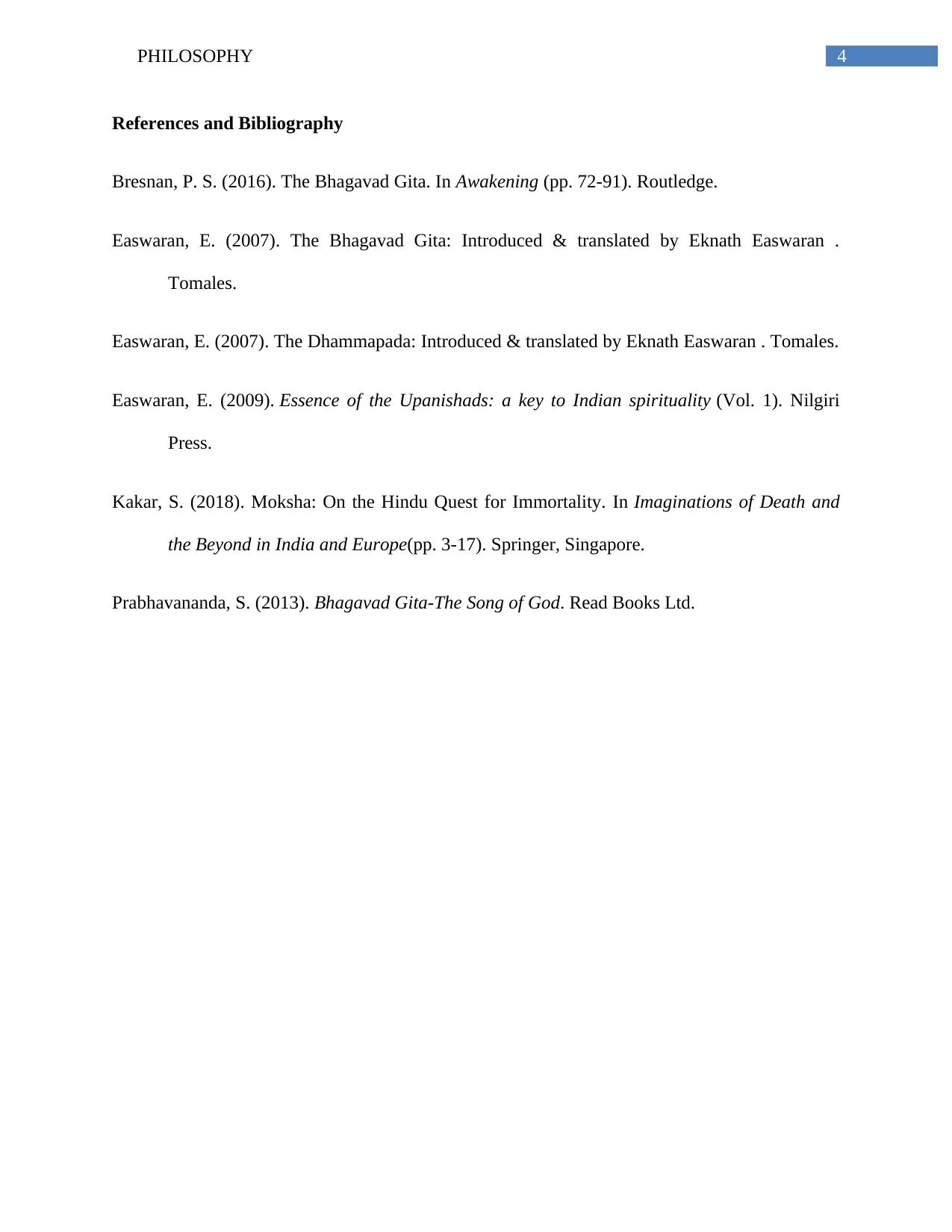
4PHILOSOPHY
References and Bibliography
Bresnan, P. S. (2016). The Bhagavad Gita. In Awakening (pp. 72-91). Routledge.
Easwaran, E. (2007). The Bhagavad Gita: Introduced & translated by Eknath Easwaran .
Tomales.
Easwaran, E. (2007). The Dhammapada: Introduced & translated by Eknath Easwaran . Tomales.
Easwaran, E. (2009). Essence of the Upanishads: a key to Indian spirituality (Vol. 1). Nilgiri
Press.
Kakar, S. (2018). Moksha: On the Hindu Quest for Immortality. In Imaginations of Death and
the Beyond in India and Europe(pp. 3-17). Springer, Singapore.
Prabhavananda, S. (2013). Bhagavad Gita-The Song of God. Read Books Ltd.
References and Bibliography
Bresnan, P. S. (2016). The Bhagavad Gita. In Awakening (pp. 72-91). Routledge.
Easwaran, E. (2007). The Bhagavad Gita: Introduced & translated by Eknath Easwaran .
Tomales.
Easwaran, E. (2007). The Dhammapada: Introduced & translated by Eknath Easwaran . Tomales.
Easwaran, E. (2009). Essence of the Upanishads: a key to Indian spirituality (Vol. 1). Nilgiri
Press.
Kakar, S. (2018). Moksha: On the Hindu Quest for Immortality. In Imaginations of Death and
the Beyond in India and Europe(pp. 3-17). Springer, Singapore.
Prabhavananda, S. (2013). Bhagavad Gita-The Song of God. Read Books Ltd.
1 out of 5
Related Documents
Your All-in-One AI-Powered Toolkit for Academic Success.
+13062052269
info@desklib.com
Available 24*7 on WhatsApp / Email
![[object Object]](/_next/static/media/star-bottom.7253800d.svg)
Unlock your academic potential
Copyright © 2020–2025 A2Z Services. All Rights Reserved. Developed and managed by ZUCOL.





